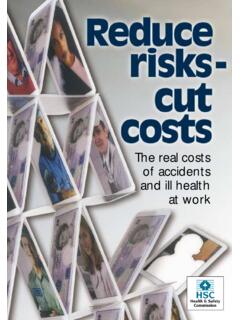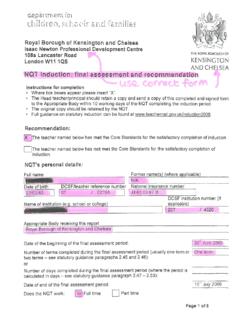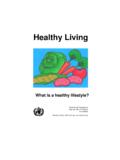Transcription of The Minibeast Pack - Royal Borough of Kensington and Chelsea
1 The Ecology Service 2010 The Minibeast Pack Background information and resources for teachers Date published 26/04/10 Title option here dependent on image 30 - 42pt Sub-title, if required, goes here 18 - 26pt For further information contact: Holland Park Ecology Centre The Stable Yard Ilchester Place London W8 6LU Tel: 020 7938 8186 Email: 2 To book a self led session or one led by a member of the Ecology staff or for further information contact: Holland Park Ecology Centre Stableyard Ilchester Place London W8 6LU Tel: 020 7938 8186 Email: Website: Contents Page Title Page number Introduction and aims 3 Holland Park Ecology Centre and Wildlife Area 4 How to conduct a Minibeast hunt 5 Health and safety and risk assessment 7 Pre-visit ideas 8 Post visit ideas 9 Minibeast or invertebrate groups 10 Food chains and food webs 12 Invertebrate identification sheets and key 14 Worksheets 19 Glossary 29 Letter to class about their forthcoming visit 30 3 Introduction This pack contains useful resources and ideas about Minibeast hunting at Holland Park for KS1 and KS2 teachers.
2 The content and activities can be adapted to suit the different needs of classes and age groups. It aims to give teachers a better understanding of invertebrates and habitats and provides suggestions for pre and post visit activities. The pack contains photocopiable worksheets and identification sheets that may be used on the visit or could form the basis for follow up work. Key vocabulary is written in bold in the text and a short definition of each term can be found in the What is a Minibeast ? The term Minibeast is a more child friendly term for any small invertebrate. An invertebrate is an animal without a backbone and there are a vast range of different species; insects, arachnids, worms, slugs and snails are all invertebrates. Further information on commonly found species can be found on page 9.
3 Why hunt them? A Minibeast hunt in the wildlife area is a simple and very enjoyable way for children to discover more about the natural world. The science content can be tailored to meet the needs of any age group. 4 Holland Park Ecology Centre and Wildlife Area The Ecology Centre provides a base for studying the ecology and environment of the park. It has classroom and presentation facilities, curriculum-related displays, live and static animal specimens and a reference library. A range of scientific equipment is available for outdoor use. The centre can cater for groups of up to thirty children with accompanying adults. Holland Park Wildlife Area has a wildlife pond with dipping platform, woodland paths extending round the enclosure, and three distinct habitats to study pond, woodland and grassland.
4 Sessions to the centre can be self led or led by a ecology education officer. 5 How to conduct a Minibeast hunt Minibeast or invertebrates are found in a diverse range of terrestrial and aquatic habitats and there are many different ways of collecting them. Three methods given are suitable for children to hunt for invertebrates in a woodland and grassland habitat. In all collecting children should be encouraged to use a plastic spoon to pick up creatures as some minibeasts are very delicate. Woodland floor log turning A great variety of invertebrates live in the leaf litter and under logs and stones. Organise your group into pairs and give each pair a magnifier pot and spoon. Ask the children to search under logs and stones for invertebrates. The creatures found can be scooped up with the spoons and placed in pots.
5 Remind the children to put back the logs exactly as they found them and after examining the creatures the invertebrates should be place back under logs. A number of different creatures can go in one pot but large snails and slugs are best in pots by themselves as they will produce a lot of sticky slime that can cover and harm the other creatures. H & S The children should lift and replace logs carefully, watching out for fingers and toes. Larger logs should be lifted by adults only. 6 Sweep nets This method is suitable for finding out what invertebrates live in long grass and stinging nettles. Equipment needed: a sweep net, magnifier collection pots and spoons Using a sweep net a child makes broad long sweeps of the net through long grass or nettles. After sweeping the inside of the net can be examined for creatures.
6 Points to note: check no one will be hit by the net when sweeping and try to avoid sweep near thorny plants as these will catch on the net. If sweeping through nettles be careful examining the contents as there may be bits of nettles inside the net. Tree beating This method can be employed to see what creatures live in the canopy of the trees. Equipment needed: a beating sheet, magnifier collection pots and spoons To do tree beating one child holds a beating sheet under a branch of a tree or a bush whilst another person shakes vigorously the branch. Any creatures on the branch will fall on to the beating sheet. The creatures disturbed tend to be fast moving ones like spiders or flying ones like lacewings. 7 Health and Safety and Risk Assessment Minibeast or invertebrate hunting is a very enjoyable activity but it does carry a number of potential risks but these can be easily reduced by following these guidelines 1.
7 Group ratio Please ensure you have a ratio of at least 1 to 6 by the pond for KS2. I:2 for very young children . 2. Behaviour in the woods all children should be made aware of the parameters of the Minibeast hunting area. 3. To prevent infections children should be reminded not to put their fingers in theirs mouth, nose or eyes and should wash their hands afterwards. 4. The hazards of touching plants like stinging nettles, holly and brambles should be explained to all visiting groups. The eating of berries and fungi should be warned against as some are very poisonous. 5. The Wildlife Area is regularly checked however care should taken walking around for trip hazards and fallen branches. On rare occasions wasps nest under logs; if you do discover a nest please vacate that area immediately and report where the nest is to the Ecology Centre.
8 6. Insects stings please check with your class any children with allergies to insect stings. If any member of your group is stung by a bee or wasp please seek first aid and report the incident to the Ecology Centre. A full risk assessment for this activity is available on our website. Please contact the Ecology centre for further enquiries. It is advisable to have the ecology centre and parks police numbers to hand when at the wildlife area in Holland Park. 8 Pre-visit ideas Before coming to the Ecology Centre with your class you may find the following ideas useful to set the scene and for further learning. A Minibeast hunt is often conducted as part of a science unit about the living world but there is often scope to introduce a cross curricular element as well. The term Minibeast is often used but is interchangeable with invertebrate.
9 Carry out a Minibeast survey/hunt in your school grounds so to compare with the Ecology area. Discuss the term Minibeast and invertebrate compare and contrast with other animals include themselves and other animals. Possible themes could be appearance, lifecycle, movement and how they breathe. Investigate the number of legs and body parts common invertebrates have. Ask them to research their favourite Minibeast internet or book based Discuss where we find minibeasts and what all animals need to survive. For younger children share story books like The Very Hungry Caterpillar by Eric Carle. For longer reads books like Harry the Poisonous Centipede by Lynne Reid Banks or Charlotte s Web by E. B. White will spark interest. Explain what a habitat is and talk about different habitats they might find in around the school and in Holland Park.
10 For older children the term micro habitats could also be introduced. Read the letter to class (see appendix 1) as away of introducing the trip to your group and prompting questions (letter is suitable for KS1 and lower KS2). Work on keys to identity creatures or objects. PSHE work on caring for the environment and how to care and respect living things. 9 Post visit ideas A Minibeast hunt can form part of a teaching unit in Science. It can also be the basis for other cross curricular topics as well. Create mini beast clay monsters using clay and natural materials from the wildlife area. Create a giant land art mini beast using found materials gathered in the wildlife area research land art by artists such as Andy Goldsworthy Display work about minibeasts- children could draw or paint different minibeasts this could help reinforce work on adaptation, camouflage etc.











